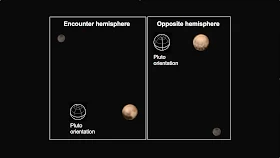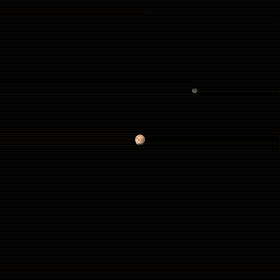Καλλιτεχνική
απεικόνιση των νεφών στον Πλούτωνα. An artist’s conception of clouds in
Pluto’s atmosphere. Credits:
JHUAPL
Αν
ο Πλούτωνας έχει σύννεφα, τότε η αποστολή New Horizons μπορεί να τα εντοπίσει.
Οι
τελευταίες έγχρωμες εικόνες του Πλούτωνα (και του δορυφόρου Χάροντα) από το
διαστημικό σκάφος New
Horizons. New
Horizons team members combined black-and-white images of Pluto and Charon from
the spacecraft’s Long-Range Reconnaissance Imager (LORRI) with lower-resolution
color data from the Ralph instrument to produce these views. We see the planet
and its largest moon in approximately true color, that is, the way they would
appear if you were riding on the New Horizons spacecraft. About half of Pluto
is imaged, which means features shown near the bottom of the dwarf planet are
at approximately at the equatorial line.
Οι
φωτογραφίες υψηλής ανάλυσης που στέλνει το διαστημικό σκάφος θα μπορούσαν,
χρησιμοποιώντας μια σειρά από ειδικές τεχνικές, να μας αποκαλύψουν την ύπαρξη
ατμόσφαιρας.
Φωτογραφίες
που ελήφθησαν μεταξύ 23ης και 29ης του Ιουνίου 2015, όταν η απόσταση του
διαστημικού σκάφους Νέοι Ορίζοντες από τον Πλούτωνα ήταν 24 εκατομμύρια έως 18
εκατομμύρια χιλιόμετρα. This is the first movie created by New Horizons to
reveal color surface features of Pluto and its largest moon Charon. “It’s a bit
unusual to see so much surface detail at this distance,” said New Horizons
co-investigator William McKinnon of the Geology and Geophysics Investigation
Team, Washington University in Saint Louis. “What’s especially noteworthy is
the level of detail in both bodies. It’s certainly whetting our appetite for
what’s to come.” The images were taken between June 23 and June 29, 2015, as
New Horizons’ distance to Pluto decreased from a distance of 15 million to 11
million miles (24 million to 18 million kilometers). Six high-resolution
black-and-white images from New Horizons’ LORRI instrument were combined with
color data from the Ralph instrument to produce the movie.
Σύμφωνα
με τους ερευνητές ο εντοπισμός των νεφών θα επιτρέψει τον προσδιορισμό των
ταχυτήτων και των διευθύνσεων των ανέμων στον πλανήτη-νάνο Πλούτωνα.
Πηγή: www.nasa.gov
Πηγή: www.nasa.gov



